
At What Weight Is a Patient Considered to Be Bariatric ?
📋 KEY TAKEAWAYS
| Classification | Weight Threshold | BMI Range |
|---|---|---|
| Clinical Bariatric | 300+ pounds (136+ kg) | BMI 40+ |
| Equipment Threshold | 250-300+ pounds (113-136+ kg) | BMI 35+ |
| Insurance Classification | Usually 300+ pounds | BMI 40+ or 35+ with comorbidities |
Best Bariatric Hospital Bed: Medacure Bariatric Adjustable Bed Lincoln LX-BARI-S with Scale – Supports up to 750 lbs with integrated scale
Best Bariatric Mattress: Medacure Bariatric Mattress with Low Air Loss – Therapeutic support for pressure management
Best Value Bariatric Bed: Full Electric Bariatric Hospital Bed Costcare B142C – Reliable support at an accessible price point
At what weight is a patient considered to be bariatric? A patient is typically classified as bariatric when they weigh 300 pounds (136 kg) or more, or have a Body Mass Index (BMI) of 40 or greater.
However, equipment needs and classification thresholds can begin at 250 pounds (113 kg) or a BMI of 35+, depending on healthcare facility protocols and equipment specifications.
This weight classification determines the need for specialized hospital beds, bariatric hospital beds, and hospital bed mattresses designed to safely accommodate higher weight capacities.
Understanding the precise weight thresholds for bariatric classification is crucial for ensuring proper patient care, safety, and equipment selection. This comprehensive guide will explain the various definitions of bariatric status, why these thresholds matter, and how to select appropriate bariatric equipment for different weight ranges.
Official Medical Definitions of Bariatric Status
The term "bariatric" relates to the branch of medicine dealing with obesity treatment. While there isn't a single universal definition, several authoritative medical organizations provide guidelines for bariatric classification.
| Organization | Weight Classification | BMI Classification |
|---|---|---|
| American Society for Metabolic and Bariatric Surgery (ASMBS) | Not specified by weight alone | BMI ≥ 40 kg/m², or BMI ≥ 35 kg/m² with obesity-related conditions |
| Centers for Medicare & Medicaid Services (CMS) | Generally 300+ pounds | BMI ≥ 40 kg/m², or BMI ≥ 35 kg/m² with at least one comorbidity |
| Healthcare Facilities | Often 250-300+ pounds | Often BMI ≥ 35 kg/m² |
| Equipment Manufacturers | Typically 250-300+ pounds | Not typically specified by BMI |
Clinical Definition Based on BMI
From a clinical perspective, bariatric status is more commonly defined using Body Mass Index (BMI) rather than weight alone:
- Class I Obesity: BMI 30-34.9 kg/m² (generally not considered bariatric)
- Class II Obesity: BMI 35-39.9 kg/m² (sometimes considered bariatric, especially with comorbidities)
- Class III Obesity (Severe/Morbid Obesity): BMI ≥ 40 kg/m² (universally considered bariatric)
- Super Obesity: BMI ≥ 50 kg/m² (advanced bariatric status)
- Super-Super Obesity: BMI ≥ 60 kg/m² (extreme bariatric status)
For healthcare practices, patients with a BMI of 40 or higher are almost always classified as bariatric. Patients with BMIs between 35-40 are often classified as bariatric if they have obesity-related health conditions such as type 2 diabetes, hypertension, or sleep apnea.
Equipment-Based Definition
Equipment-based classifications often use more specific weight thresholds than clinical definitions because they relate directly to safety ratings and physical capabilities of medical equipment.
The Medacure HCFE42 Bariatric Hospital Bed is specifically designed for bariatric patients, with a weight capacity exceeding standard hospital beds.
Weight thresholds for standard vs. bariatric equipment:
- Standard Hospital Beds: 350-450 pounds capacity
- Basic Bariatric Equipment: 450-600 pounds capacity
- Heavy-Duty Bariatric Equipment: 600-750 pounds capacity
- Ultra Bariatric Equipment: 750-1000+ pounds capacity
Why Weight Thresholds Matter for Medical Equipment
Understanding the specific weight at which a patient is considered bariatric is crucial for selecting appropriate equipment that ensures both patient safety and caregiver wellbeing.
Safety Concerns with Standard Equipment
Using standard medical equipment for patients above bariatric thresholds creates significant risks:
- Structural Failure: Beds, lifts, or wheelchairs may break under excessive weight
- Instability: Equipment may become unstable, increasing fall risks
- Pressure Injuries: Inadequate support surfaces can cause tissue damage
- Impaired Care Delivery: Caregivers cannot properly position or transfer patients
- Patient Dignity Issues: Ill-fitting equipment compromises privacy and comfort
The Full Electric Bariatric Hospital Bed Costcare B142C addresses these concerns with a reinforced frame designed specifically for higher weight capacities.
Bariatric Equipment Design Differences
| Feature | Standard Equipment | Bariatric Equipment |
|---|---|---|
| Frame Construction | Standard steel tubing | Reinforced, heavy-gauge steel |
| Width Dimensions | 35-36" typical width | 42-60" expanded width |
| Motor Systems | Standard motors | Heavy-duty motors with higher torque |
| Weight Distribution | Central support | Distributed support system |
| Mattress Support | Standard deck | Reinforced deck with additional supports |
Insurance and Documentation Requirements
Insurance coverage for bariatric equipment typically requires specific documentation:
- Documented Weight/BMI: Precise measurements demonstrating bariatric status
- Medical Necessity: Physician statement explaining need for bariatric equipment
- Equipment Specifications: Documentation showing standard equipment is insufficient
- Functional Limitations: Description of mobility restrictions requiring specialized equipment
- Prior Authorization: Often required for higher-cost bariatric items
The Heavy Duty Hospital Bed Costcare B357 offers flexible width options (42"-48") that can be documented to match specific patient needs, supporting insurance approval.
Appropriate Bariatric Equipment for Different Weight Ranges
Selecting the right equipment based on specific weight ranges ensures both safety and appropriate resource allocation. Bariatric equipment is typically categorized by weight capacity tiers.
Weight Range: 250-350 pounds (113-159 kg)
Patients in this weight range fall into a transitional category that may not always be classified as bariatric, but often exceed standard equipment capacities:
- Beds: Heavy-duty standard or entry-level bariatric beds
- Mattresses: Reinforced foam or entry-level bariatric pressure management systems
- Mobility Devices: Reinforced wheelchairs or walkers with higher weight ratings
For this weight range, the Costcare Full Electric Hospital Bed B135C offers a 450-pound capacity that accommodates patients at the upper end of standard equipment capabilities.
Recommended equipment for 250-350 pound range:
- Hospital beds with 400-500 pound capacity
- Reinforced wheelchairs with 400+ pound rating
- Standard bariatric walkers and commodes
Weight Range: 350-500 pounds (159-227 kg)
Patients in this range require dedicated bariatric equipment:
- Beds: Purpose-built bariatric beds with reinforced frames
- Mattresses: Bariatric pressure redistribution systems
- Transfer Equipment: Patient lifts rated for bariatric weights
- Mobility Devices: Specialized bariatric wheelchairs and walkers
The Medacure Bariatric Mattress with Low Air Loss provides important pressure management for patients in this weight category, helping prevent tissue damage and improve comfort.
Weight Range: 500-750+ pounds (227-340+ kg)
Patients exceeding 500 pounds require specialized heavy-duty bariatric equipment:
- Beds: Heavy-duty bariatric beds with expanded width options
- Mattresses: Advanced bariatric air systems with lateral rotation
- Mobility Systems: Ultra-capacity wheelchairs and specialized mobility aids
- Room Modifications: Structural reinforcement may be needed for ceiling lifts
For these higher weight capacities, the Medacure Bariatric Adjustable Bed Lincoln LX-BARI-S with Scale offers a 750-pound capacity with an integrated scale for weight monitoring, making it ideal for heavier bariatric patients.
Bariatric Mattress Requirements
The mattress is a critical component of bariatric care, as inadequate support surfaces can lead to serious complications including pressure injuries, respiratory compromise, and mobility limitations.
Key Bariatric Mattress Features
Hospital bed mattresses for bariatric patients must include:
- Increased Weight Capacity: Rated for the patient's specific weight
- Appropriate Width: Matching the expanded width of bariatric beds
- Pressure Redistribution: Specialized zones to prevent pressure injuries
- Edge Support: Reinforced edges for safer transfers
- Heat/Moisture Management: Systems to prevent skin maceration
- Proper Thickness: Usually 6-10 inches to prevent bottoming out
The Emerald Comfort Select Pressure Redistribution Bariatric Foam Mattress features specialized zoning designed specifically for bariatric pressure management.
Types of Bariatric Mattresses
| Mattress Type | Weight Capacity | Best For |
|---|---|---|
| Bariatric Foam | Up to 500-600 lbs | Basic support, lower pressure injury risk |
| Bariatric Alternating Pressure | Up to 650-750 lbs | Active pressure injury prevention/treatment |
| Bariatric Low Air Loss | Up to 750-1000 lbs | Moisture/heat management, advanced pressure care |
| Bariatric Air Fluidized | Up to 1000+ lbs | Severe pressure injuries, complex bariatric care |
For advanced pressure management, the Emerald Bariatric Mattress w/ Digital Alternating Pressure LAL System combines alternating pressure therapy with low air loss technology specifically designed for bariatric patients.
Hospital Bed Requirements for Bariatric Patients
Selecting the appropriate bariatric hospital bed involves considering several critical factors beyond simple weight capacity.
Width and Size Considerations
Standard hospital beds are typically 36" wide, which is inadequate for most bariatric patients. Bariatric bed options include:
- 42" Width: Entry-level bariatric width, suitable for BMI 35-45
- 48" Width: Mid-range bariatric width, suitable for BMI 45-55
- 54" Width: Enhanced width for larger bariatric patients
- 60" Width: Maximum width for extreme bariatric needs
The Costcare Bariatric Adjustable Hospital Bed B359 offers extra-wide options up to 60 inches to accommodate larger patients.
Frame Construction and Safety Features
Bariatric beds require enhanced structural elements:
- Reinforced Frame: Heavy-gauge steel construction
- Additional Cross Supports: Prevents frame deformation
- Distributed Weight Design: Multiple support points rather than central support
- Enhanced Articulation Motors: Higher torque capability
- Expanded Footprint: Wider base for stability
Mobility and Transfer Features
Safe mobility is critical for bariatric patients:
- Height Adjustability: Lower heights for safer transfers
- Expanded Transfer Area: Reinforced edges for sitting and transfers
- Integrated Scale Systems: Weight monitoring without transfers
- Enhanced Side Rails: Proper positioning and support during movement
- Compatibility with Lift Systems: Integration with ceiling or floor-based lifts
Our Top Recommendations for Bariatric Equipment
Based on extensive research and product evaluation, we recommend these top bariatric products for different needs:
Best Overall Bariatric Hospital Bed
The Medacure Bariatric Adjustable Bed Lincoln LX-BARI-S with Scale ($3,495) stands out as our top recommendation for bariatric care due to its:
- Exceptional 750 lb Weight Capacity: Suitable for most bariatric needs
- Width Options: Available in 36", 42", or 48" widths
- Integrated Scale: Allows weight monitoring without transfers
- Full Electric Controls: Easy position adjustment for comfort and care
- Premium Construction: Durable frame with enhanced support system
Best Value Bariatric Hospital Bed
For those seeking excellent bariatric support at a more accessible price point, the Full Electric Bariatric Hospital Bed Costcare B142C ($1,842) offers:
- 600 lb Weight Capacity: Suitable for most bariatric needs
- Full Electric Functionality: Complete position control
- Reinforced Frame: Durable bariatric construction
- Standard 42" Width: Accommodates most bariatric patients
- Excellent Price-to-Performance Ratio: Quality bariatric features at mid-range pricing
Best Bariatric Mattress System
For optimal pressure management, the Medacure Bariatric Mattress with Low Air Loss offers:
- Advanced Pressure Distribution: Therapeutic air cell design
- Active Moisture Management: Low air loss technology prevents skin maceration
- Bariatric-Specific Design: 42" width compatible with bariatric beds
- Digital Control Unit: Customizable pressure settings
- Durable Construction: Reinforced base and air cells for bariatric weights
Frequently Asked Questions
At what exact weight is someone officially considered bariatric?
Most healthcare facilities classify patients as bariatric at 300+ pounds (136 kg) or a BMI of 40+. However, equipment needs may begin at 250 pounds, and clinical classification sometimes starts at BMI 35+ with comorbidities.
Does Medicare cover bariatric equipment?
Medicare typically covers 80% of approved bariatric equipment when deemed medically necessary with proper documentation including physician prescription, documented weight/BMI, and demonstrated need for specialized equipment.
What's the difference between standard and bariatric hospital beds?
Bariatric hospital beds have reinforced frames (supporting 500-1000 pounds vs. 350-450), wider sleep surfaces (42"-60" vs. 36"), heavy-duty motors, and distributed weight support systems designed for higher weight capacities.
Do bariatric patients always need special mattresses?
Yes, bariatric patients require specialized mattresses to prevent pressure injuries, provide adequate support, and ensure comfort. Standard mattresses compress excessively under higher weights, creating safety and health risks.
Can standard hospital beds be modified for bariatric patients?
No, standard hospital beds cannot be safely modified for true bariatric use. Attempting modifications risks structural failure, voiding warranties, and creating serious safety hazards for patients and caregivers.
What width hospital bed is best for bariatric patients?
The appropriate width depends on patient size: 42" beds suit patients with BMI 35-45, 48" beds for BMI 45-55, and 54"-60" beds for larger patients. The bed should allow proper positioning without excessive gap between patient and side rails.
Are bariatric hospital beds covered by insurance?
Bariatric hospital beds are typically covered by insurance when medically necessary, properly prescribed, and the patient meets weight/BMI thresholds (usually 300+ pounds or BMI 40+). Prior authorization is often required.











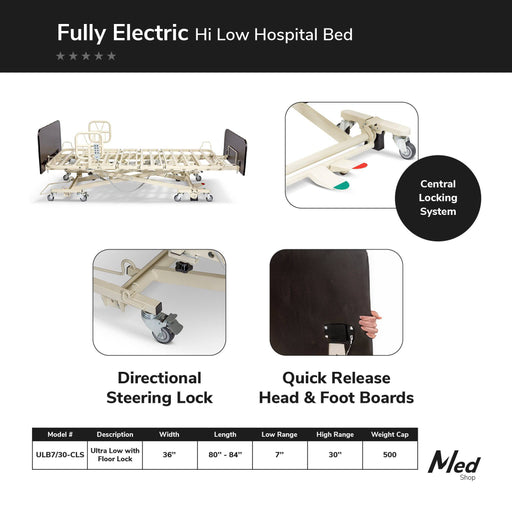
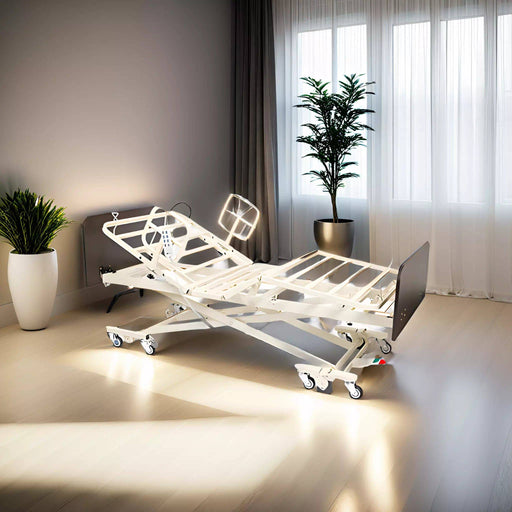



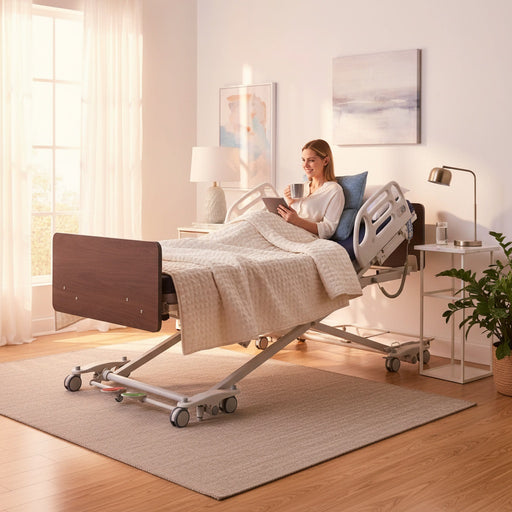
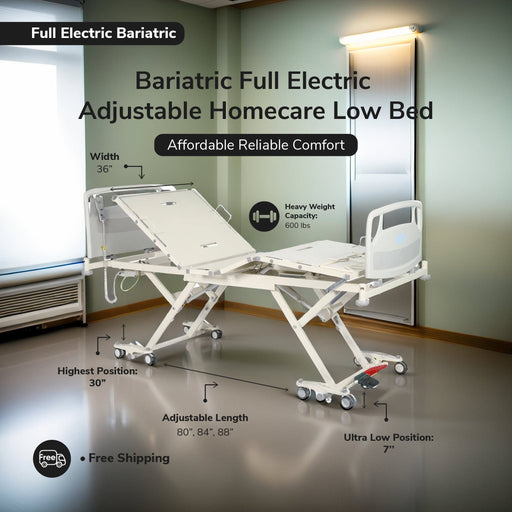
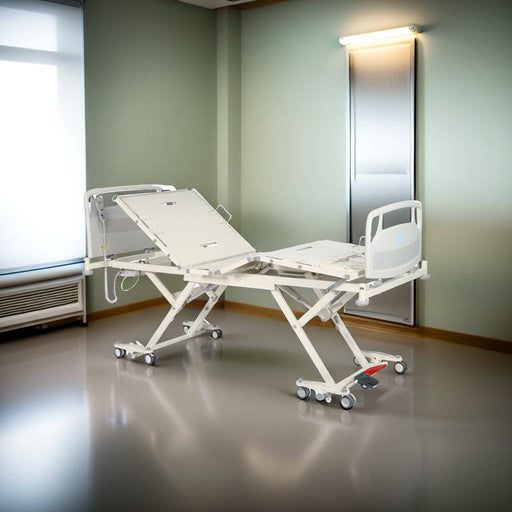
Leave a comment